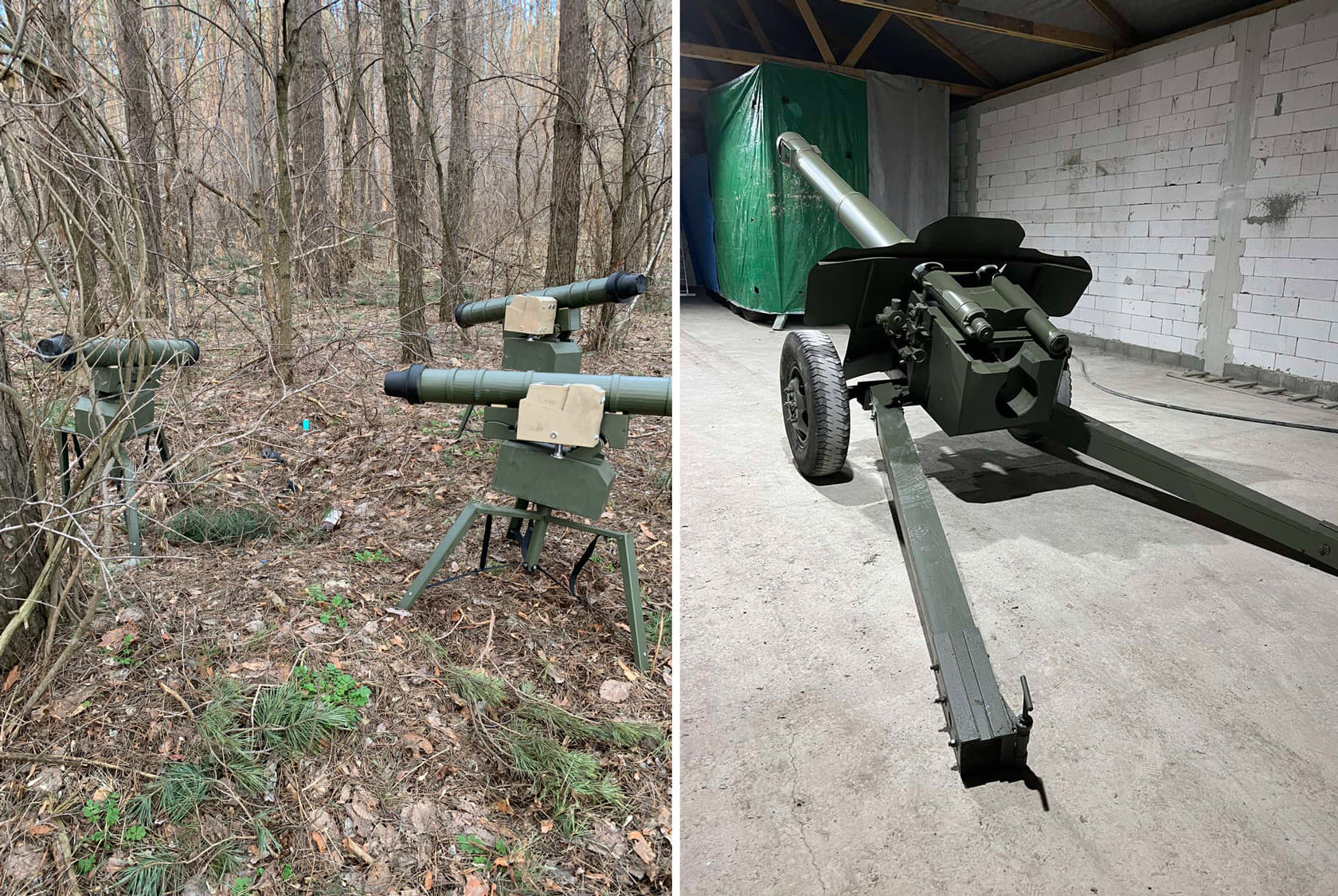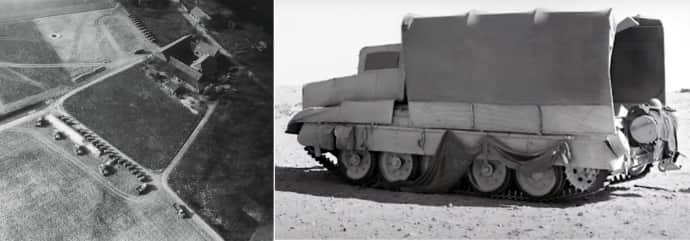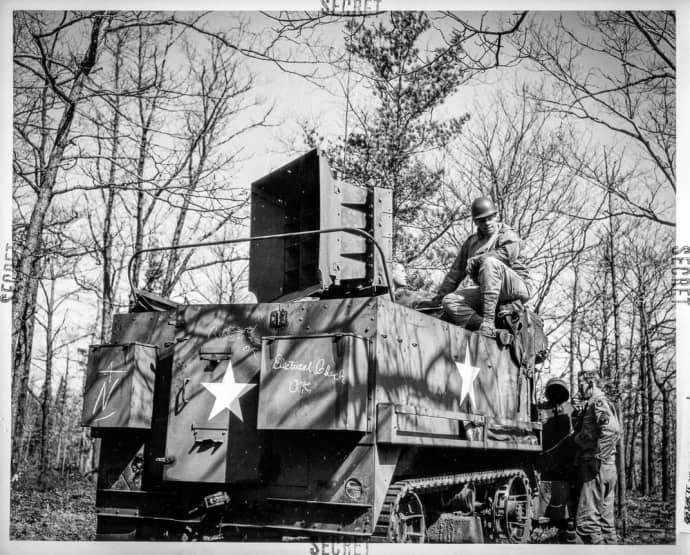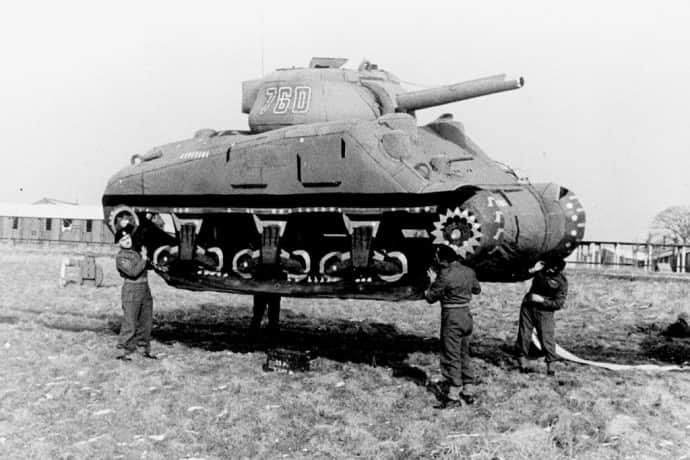Real Kalibr missiles vs HIMARS decoys. How fake weapons are used at the front
"Commander, trap number two has worked!" the Ukrainian soldier says with joy. The Russians just destroyed his howitzer and he shows its battered barrel on camera. Made from aluminium.
Don't rush to accuse the soldier of treason. This is about a fake artillery system which the Russians used valuable munition to destroy. Throughout human history, fake weapon decoys have been used as long as there have been wars, which means always.
The ancient Greeks knew that deceiving the enemy was more effective than launching bloody assaults on the fortress of Troy.
Advertisement:Fake weapons are the only type created solely to be destroyed by the enemy as quickly as possible. They are the only type of weapon that is not concealed from the enemy, but rather left in plain view. They are the only artificial scenery in the theatre of operations, where everything else, weapons, life and death, is real.
Fake weapons don't receive an Oscar nomination for best visual effects. However, they protect soldiers' lives and preserve equipment. Those involved in the development, production and use of such fakes told Ukrainska Pravda about how "fake" weapons are employed at the front now.
They also noted several examples of how dummy tanks and artillery pieces have helped achieve victory. Disclaimer: No secrets were revealed during the preparation of this article. We only used information confirmed by our sources and that is available to the public.
Advertisement:In the beginning, there was the Stugna anti-tank guided missile system
The faint-hearted are better off not knowing how, during the first months of the full-scale war, Ukrainian defenders camouflaged their weapons to deceive the Russians, preserving their combat capability and equipment.
The short answer is that they used whatever was at hand at the time. Mykhailo Roman, coordinator of the Movement to Support the Zakarpattia Military - Vynohradiv Office organisation and other volunteers, who regularly went to the front in Ukraine's east, witnessed this firsthand. Upon returning home after another trip, they made their first Stugna anti-tank guided missile system decoy from metal, plastic drainage pipes and wood.
"The soldiers say that the main problem with those decoys is that they don't shoot, but everything else is identical to the original," Roman told Ukrainska Pravda.
 The fake Stugna anti-tank guided missiles and D-20 howitzers made by volunteers from Zakarpattia for Ukrainian defenders.Photo: Mykhailo Roman
The fake Stugna anti-tank guided missiles and D-20 howitzers made by volunteers from Zakarpattia for Ukrainian defenders.Photo: Mykhailo Roman
With pride, he shows the videos Ukrainian defenders have sent to him from the front. "Look how the Russians strike, the morons," a voice off-camera marvels, demonstrating the damaged decoys after another round of Russian shells. "Twenty rounds per shot, twenty thousand bucks for each Stugna made by your guys." The cost breakdown is interesting: initially, Roman's production cost for the first Stugna decoys was 3,000-4,000 hryvnias [about £78-104] each.
Later, they cost only 1,000 [about £26]. In total, they sent up to 200 such fakes to the front line. All were built according to the requests of soldiers from affiliated units, without the involvement of the General Staff.
Later, Roman took on making his first decoy of the D-20 howitzer gun, 14 metres in length. It took two months to complete. Some crafted details, some painted and some welded.
They thought long and hard about how to name this gun. They decided that the perfect name would be Bosorkania. She's a mythological character, a Zakarpattia witch.
The hint is clear: sooner or later, she will come to every occupier. "We won't stop there. We'll definitely get to making a fake tank," Roman asserts. "I got a call from the General Staff yesterday.
They want to meet and discuss how to scale up our know-how." Several fake weapon producers have told us that lately, the General Staff has been trying to bring "independent volunteers", who had previously been in direct contact with the units of Ukraine's Armed Forces, under its wing.
Advertisement:The use of fake weapons in the war in Ukraine
"The issue is sensitive and such information is not for public discussion," is how the General Staff responded to Ukrainska Pravda's inquiry about the use of fake weapons. Caution in this case is understandable.
However, it does not guarantee that information about the use of decoys in Ukraine's Armed Forces will not eventually appear in the Western media. The Washington Post dedicated an article in August 2022 to how the Russian army was hunting down wooden decoys of HIMARS multiple-launch rocket systems in Ukraine. The Russian Defence Ministry reported almost daily on the destruction of these installations.
"They've claimed to have hit more HIMARS than we have even sent," a US diplomat noted in a conversation with journalists. The Washington Post stated that the Russians wasted at least 10 Kalibr missiles on destroying fakes in just the first week after they started to be used. The cost of each missile varies, ranging from £1 million [according to Defence Express] to £6.5 million [Forbes].
One major Ukrainian business made a replica of this HIMARS launcher just before Ukraine's Armed Forces received the real one. "Externally, the decoy had no differences from the original. Down to the smallest details," Ukrainska Pravda's source involved in the project said anonymously. "When it was moving, you could only tell by the sound of the gears shifting that it was a modified truck.
But you have to be an expert to hear that. One of the top Ukrainian officials saw this product for the first time and asked the head of the company: 'What's a HIMARS doing here?'" The decoy with the crew served as bait for Russian missiles.
But besides this, it performed another function. On another vehicle, specially trained individuals with special equipment rode and "live baited" those who informed the Russians about the movement of HIMARS. This was a comprehensive solution to decoy Russian missiles and at the same time clear Ukrainian ranks of those who spy in favour of the Russians, both among the military and the local population.
Metinvest [an international group of steel and mining companies] became the main newsmaker on this sensitive topic in August-September 2023. The company announced that it had set up production and transferred over 250 mock-ups to Ukraine's Armed Forces, replicating the appearance of radar stations and artillery pieces.
Advertisement:The Guardian, Financial Times and CNN aired reports on Metinvest's production of fake weapons in autumn 2023. In response to questions about the types of weapons the company fakes, Metinvest's Chief Operations Officer Oleksandr Mironenko mentioned D-20, D-30 and M777 howitzers as well as several types of radar stations.
Metinvest's social media accounts posted updates and videos about the destruction of a Ukrainian-made Malakhit radar decoy by the Russians in September 2023. Since then, the company has been working on dummy weapons in "silence mode" for almost half a year. "For updated information, it is better to contact those responsible for using dummies in the Armed Forces of Ukraine," Metinvest responded to the Ukrainska Pravda's request as succinctly as the General Staff.
 Howitzers are one of the types of replica weapons produced by Metinvest for the Armed Forces of UkrainePhoto: Metinvest Group
Howitzers are one of the types of replica weapons produced by Metinvest for the Armed Forces of UkrainePhoto: Metinvest Group
Even the Russians pay tribute to the quality of the fakes used by the Ukrainian Defence Forces. In early March 2024, the "Z-channels" of Russian propagandists spread a message that after the retreat of Ukrainian troops from Avdiivka, the Russians had looted a mock-up of a Sentinel radar station.
"It is difficult to understand that this is a dummy even on the ground, and even more so from the air," they stated in surprise. However, nothing can undermine their confidence that such dummies are received from Western partners along with other military assistance, and are not produced in Ukraine. However, there is no reliable information yet on whether the allies are supplying Ukraine with mock weapons.
In the spring of 2023, news appeared on Reuters' and AP's websites about the Czech company Inflactech, which specialises in the manufacture of inflatable decoys, including tanks. Since the beginning of the full-scale invasion of the Russian Federation in Ukraine, it has launched the production of HIMARS mock-ups. When asked by journalists whether the company supplies products to Ukraine, its co-owner Vojtech Fresser answered evasively.
"I can imagine that if we want to support a partner country that is in trouble, we would send it inflatable decoys," Vojtech Fresser said.
Advertisement:The company's workshops in reports resemble the production of props and scenery for the filming of a war blockbuster. But the most interesting thing about this story is that, as journalists of Voice of America found out, almost 50% of the Czech company is owned by persons whose official place of residence is Moscow. Ukrainska Pravda sent a request to the Czech company for the supply of mock weapons to Ukraine, but at the time of publication of this article, it had not received a response.
Big show at El Alamein
Comparing the production of dummies of weapons with factories that create props and sets for war films is not accidental.
Where does the art of cinema end and the art of war begin? The answer to this question was better known to Geoffrey Barkas, director of two dozen films made between the world wars. Even cinephiles will not remember the names of these films today, but he went down in World War II history thanks to his main work, which had the name Operation Bertram.
This blockbuster's set stretched for tens of kilometres in the Libyan Desert in northern Africa. The result of Operation Bertram was a defeat in the battle near the Egyptian city El Alamein before that invincible Desert Fox - German Field Marshal Erwin Rommel and his Africa Corps.
 Dummies of Allied weapons during World War II from the air and up close
Dummies of Allied weapons during World War II from the air and up close
In November 1941, Barkas was appointed head of the UK's Middle East Command Camouflage Directorate. This army unit included unusual characters: former artists, sculptors, directors, decorators, and even one Cambridge zoologist, an expert on the Nile crocodile and author of the textbook Adaptive Coloration in Animals.
They were supposed to mislead the enemy to hide the true intentions of their military. "The people in the camouflage unit are among the few sane beings who want their robots to be bombed," Barkes joked. Operation Bertram was the pinnacle of his unit's work.
They had to create a network of fake storage points, fake water pipes, hundreds of dummy military vehicles, and disguise 1,000 tanks as lorries to hide the true time and place of the counteroffensive. With the help of deceptive actions, Barkes had to convince the German command that the main direction of the UK attack would be in the south in the El Alamein area, and not in the north, as the UK actually planned. Several figures give an idea of the scale of this "performance": during Operation Bertram, more than 1,000 lorry mock-ups that masked tanks and awnings for howitzers, 500 tank mock-ups, and 150 mock guns were used.
Thanks to this, the offensive by General Montgomery's UK troops on 23 October surprised Rommel, and the German plans to occupy Egypt and invade the Middle East failed. "Before El Alamein, we had never had a win. We were never defeated after that," Winston Churchill said of the battle.
What should modern weapon models look like?
Unlike during Operation Bertram, when the main source of information about the enemy's plans was aerial reconnaissance, and the main requirement for weapon models was their external similarity to the original, today it is much more difficult to mislead the enemy.
In particular, due to the emergence of multispectral radars. The requirements for modern weapon models are quite strict. The French journal Defense et Securite Internationale (Defence and International Security) a few years ago devoted a separate study to this topic.
Firstly, the mock-ups must imitate not only the appearance, but also have electromagnetic, radar, thermal, and acoustic properties that are identical to the technology that is being copied. Secondly, the design should incorporate special mechanisms to simulate explosion and fire after being hit with enemy shells or missiles. Thirdly, such weapons must be disguised carefully enough so that the enemy does not sense a trap.
And at the same time, it must be effective enough for the enemy not to detect such dummy weapons. Fourthly, an important condition for using mock-ups is the minimum number of people needed to maintain them, so as not to expose them to increased danger.
Advertisement:Can Ukrainian companies and volunteers meet the needs of the Armed Forces of Ukraine in terms of decoy weapons today? Oleksandr Kamyshin, Minister of Strategic Industries, believes so.
In his opinion, we can produce mock weapons of any complexity, ranging from the cheapest inflatable ones to high-precision ones. "How it should work, look," he explains to Ukrainska Pravda. "Manufacturers say, 'We can do anything. What do you want?'.
Someone should come to them and say: 'Soon we're going to get Archers, for example. To cover these Archers, we need nine models: three inflatable, three made of plywood and three high-precision. That's it."
That's the good news. But there's bad news, too: fake weapons aren't always used systematically or effectively. "In the right hands, these dummies can save lives and protect equipment, forcing enemy forces to expend costly ammunition on dummies.
For example, different models of Iskanders could cost between £1 and £3 million. They have lost a good number of missiles trying to hit our decoys. In the wrong hands, however, dummies aren't just useless - they can even be harmful.
If they're used indiscriminately, for example, they can force enemy forces to carry out more thorough reconnaissance instead of just haphazardly firing at the dummies," a source who has been involved in producing decoys for the Armed Forces of Ukraine since the beginning of the full-scale invasion told Ukrainska Pravda on conditions of anonymity. He stressed that he agreed to discuss this issue solely to make military top brass aware of the dummies being used inappropriately. With Ukraine receiving fewer supplies of Western weapons and ammunition, ensuring the available equipment is safe is particularly important.
"The plan to create a company responsible for masking and camouflage in each brigade still hasn't been implemented. Meanwhile, military experts believe that properly using dummies of weapon systems can reduce the loss of military equipment by 30-50%. Let's put it this way: each dummy Patriot anti-aircraft missile system that gets destroyed means a real one was spared," the source told Ukrainska Pravda.
An army of ghosts
The idea of creating military units responsible for camouflage and masking weapons, including through the use of dummies and decoys, is not exactly new.
Posters advertising positions with a new unit of the US army appeared at art schools, theatres, and advertising agencies in New York, Boston, Philadelphia, Cleveland and other American cities in spring 1943. Artistic talents and creativity were listed among useful skills. A year later, in June 1944, a top-secret Ghost Army military unit - known officially as the 23rd Headquarters Special Troops - was created.
It consisted mostly of artists, architects, designers, sound engineers, set designers, decorators, and other members of what we today call the creative class. The Ghost Army counted more than 1,000 members. This engineering and masking unit used dummies of weapons and military vehicles to deceive enemy forces' aerial reconnaissance.
They could create decoy airfields, vehicle fleets, artillery batteries and tank formations, and military barracks, complete with underwear hung out to dry. Communications engineers created fake networks, pretended to be radio operators for real units, and created a facade of activity while concealing what the true targets of the Allies' attacks were. A signal service unit specialised in acoustic decoys.
They used amplifiers and speakers to recreate the sounds of infantry and tank units, with their roar heard up to 24 kilometres away.
 The "ghosts" created an acoustic illusion, making German soldiers think there were units of Allied forces where there weren't any
The "ghosts" created an acoustic illusion, making German soldiers think there were units of Allied forces where there weren't any
Captain Fred Fox wrote in his history of this unusual unit that the Ghost Army's role was "more theatrical than military. It was like a traveling road show that went up and down the front lines impersonating the real fighting outfits." Arthur Shilstone, a famous American artist and illustrator who served in the Ghost Army during World War II, recalled running into two Frenchmen on their bikes in a village in Normandy.
The Frenchmen were stunned to see four soldiers carrying a 40-tonne Sherman tank on their shoulders; it was actually an inflatable dummy. "They looked at me, and they were looking for answers, and finally I said: 'The Americans are very strong.'"
 An inflatable tank Allies used during an operation in Normandy in 1944
An inflatable tank Allies used during an operation in Normandy in 1944
Another member of the Ghost Army, Bill Blass, who later became a fashion designer who dressed Jacqueline Kennedy and Nancy Reagan, wrote about that time of his life in his memoir: "I spent the majority of the war inflating dummy tanks and dreaming up marvelous new uses for chicken feathers." During the last year of WWII, the Ghost Army carried out 20 operations in France, Luxembourg, Belgium and Germany. The Ghost Army was a top-secret unit: none of the men serving there could tell even their wives what their jobs were.
Off duty, they wore other units' insignia. They had to keep their service secret for decades. The Ghost Army wasn't publicly mentioned until 1985.
Information about the unit was only fully declassified in 1996. On 1 February 2022, US President Joe Biden signed into law the Ghost Army Congressional Gold Medal Act, decorating its members with one of the highest US state awards. Only nine of the unit's members were alive at that time.
A ceremony to present the Congressional Gold Medal to the Ghost Army will take place at the Capitol on 21 March 2024.
*** Experts are pondering what military masking and camouflage techniques will look like and what types of decoys will be used to deceive opposing forces during future wars. Many believe that the line between decoys and real weapons will grow more and more blurred.
Robotic decoys won't just be used to deceive enemy forces, but to attack them, too. Western researchers are studying how swarms of drones can be deployed to create an illusion of attack helicopters on enemy radars. Visual decoys using 3D holograms are no longer the stuff of science fiction.
Given the experience of the present war in Ukraine, Ukraine will not be a bystander in the race to design and develop these decoys and dummies, though first it faces a bigger challenge: winning the war. Something that's impossible to achieve without real weapons, even with the best dummies at its disposal. In order to win, however, Ukraine has several mistakes to address.
"When the war is over, we can share our experience with our partners," Oleksandr Kamyshin says. "Let's say they're offering a real HIMARS, three HIMARS dummies to protect it, and a manual of how to deploy this entire system: how, when, where, and to what end. Our know-how is precisely this user manual, based on our experience working with such dummies. But a manual like that has to exist.
Overall, the most important issue in 2024 is to formalise principles for the use of all sorts of weapons, from drones to weapon dummies," Kamyshin says. Mykhailo Kryhel, Ukrainska Pravda Translated by Tetiana Buchkovska, Yuliia Kravchenko, and Olya Loza
Edited by Susan McDonald